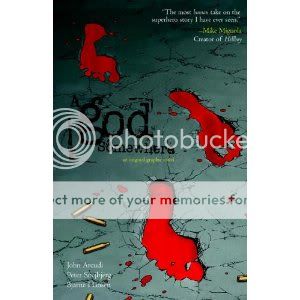A God Somewhere
John Arcudi, writer
Peter Snejbjerg, artist
DC/WildStorm, June 2010
200 pages
$24.99
As the co-writer and by all accounts driving creative force behind the Hellboy spinoff series B.P.R.D., John Arcudi is responsible for what amounts to the best ongoing superhero series on the stands. A God Somewhere is not on that level. Which, as was the case with Wednesday’s review, is perfectly fine–few things are. Moreover, much of what makes B.P.R.D. so effective is tied into just how long it’s been going on. We’ve had years and years to get acquainted with and grow attached to its characters and the neuroses they bring to their long, losing war with the paranormal–to say nothing of the ever more baroque mythology of that war itself. By contrast, A God Somewhere has to get us to care about its central quartet of characters–brothers Hugh and Eric, their best friend Sam, and Hugh’s wife Alma on whom Sam has long harbored a more-than-crush–and their paranormal plight–Eric mysteriously gains powers that make him the world’s only superhuman, but which very rapidly drive him Doctor Manhattan-style crazy in such a way as to make him the world’s only supervillain–in the space of the equivalent of four issues.
It does this mostly through shorthand. Racial and religious issues are presented in the didactic style of a Law & Order episode (or, well, a superhero comic). Plot drivers are cribbed liberally from universal superhero touchstones like Watchmen or the Incredible Hulk TV show. The creators operate under the assumption that the audience is already familiar enough with once-innovative ideas for the subgenre–Superman as Christ figure; superpowers would “really” drive a normal person into bloodthirsty madness–to take them as read. In short, it can feel rushed, even clumsy–words you’d never associate with the laconic, precision-calibrated existential action-horror-black-comedy of B.P.R.D.
But the same intelligence and willigness to discomfit that Arcudi brings to that title shows up here, even if it’s forced to fight against the constraints of the shorter format. Flashbacks that enrich our understanding of the characters and their complex quadrangle start and stop with almost Jaime Hernandez-like suddenness, with only a change in panel-border color to differentiate them from the main action, which boasts equally fanfare-free jumps forward through time. The violence is in the over-the-top True Blood-level splatter mode of similar work in Powers and Invincible, but contains enough disturbing detail, largely through the familiar sub/urban setting of some of the worst bloodbaths, to lodge in the brain and curdle in the gut. There’s at least one plot twist so unexpected and awful I didn’t even understand what I was looking at until it was made clear a couple pages later. The degree to which Arcudi is willing to leave what’s going on inside Eric’s head a mystery, allowing him to speak only in transparently faux-profundities like what Sam calls “a crazy, mass-murdering Buddha,” is refreshing and a bit haunting. Peter Snejbjerg’s warm, round character designs–his stuff here reminds me a lot of Richard Corben’s Hulk comic Banner, and not simply because of the shared subject matter–are undermined a bit by uncharacteristically bland, brown-town coloring by Bjarne Hansen, but these are still people it’s pleasant to look at even when what’s going on is super-unpleasant. Is it the landmark that the effusive blurbs from Mike Mignola and Denny O’Neil make it out to be? No, but I would argue that that’s not the intention, either. It feels to me more like an exercise: a bunch of ideas about character and concept that Arcudi wanted to try out. Even if it’s not entirely successful, that exercise was a worthwhile one.
Tags: comics, comics reviews, Comics Time, reviews

